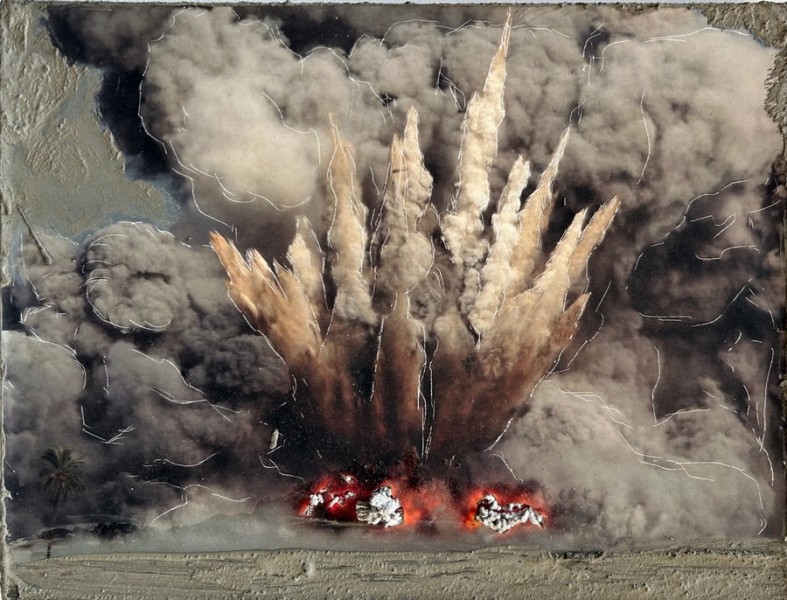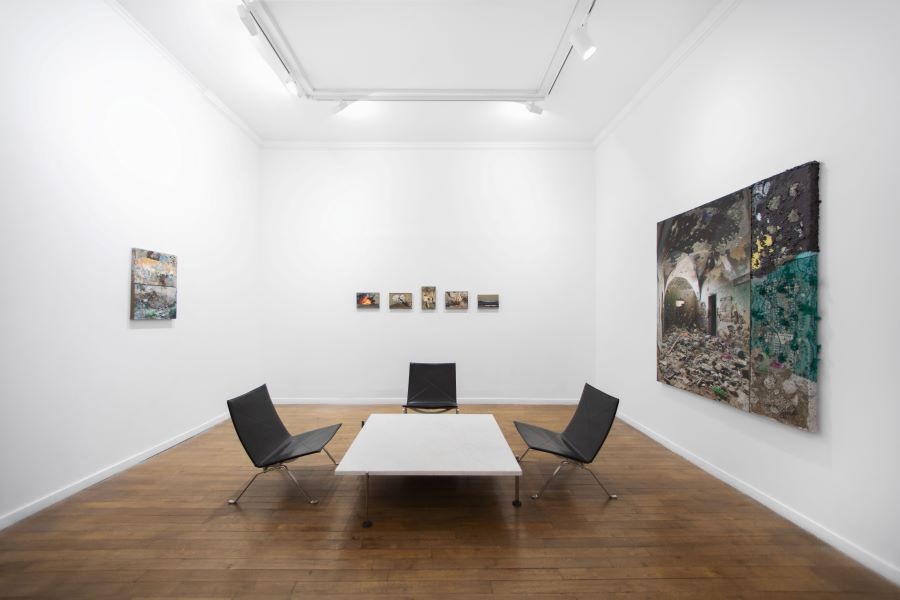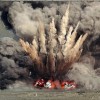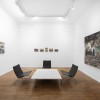Naomi Safran-Hon's second exhibition at RX&SLAG is an urgent necessity for the artist. Born in Oxford (England) in 1984, she grew up in Haifa (Israel) and now lives in New York. Her work, which bears the scars of the Israeli-Palestinian conflict, attempts to heal a wound that was reopened by the events of October 7, 2023. This exhibition, featuring works created in both 2012 and 2022, illustrates Naomi Safran-Hon's lifelong call for peace, with a purpose that goes beyond political issues. Everything in her work symbolizes reconstruction, resilience, the interweaving of histories and memories, whether through materials, forms or colors. When art is both cathartic and conveys a humanist message.
The subtitle of the exhibition could be "We all have the same sky", so much so that the artist's humanist message is bruised and revived by the dramatic events of October 7, 2023. Indeed, it is rooted in a tragedy whose outcome seems to have reached an impasse. "My work deals directly with the Israeli-Palestinian conflict, which is why it seems appropriate that I should be making this exhibition at this particular time. Some might say it's too early, as the drums of war are still beating. But presenting them today allows us to approach them in a different light, perhaps creating more space for dialogue and understanding, and helping to promote feelings of empathy." What is striking about this exhibition is that Naomi Safran-Hon places works created in 2012 and 2022 side by side, and there, before our eyes, pass a city in ruins, landscapes on fire, explosions crowned by choking grey smoke, a city view with a minaret that looks ready to be swept away by a wave of concrete... So many works that echo current events, which seem to repeat themselves ad infinitum.
"Stop the war”
The titles of the works - Time to Forget and Forgive, Looking back at absent home - are self-explanatory, as is the title of the exhibition. The time to return has come. "The Palestinians, whose homes are still empty in Haifa and many other places in Israel, have still not been allowed to return home after the war and the creation of the State of Israel in 1948. As Haifa is the artist's hometown, she is very familiar with these derelict, ruined buildings, witnesses of tragedy, suffering and raw memory. Naomi Safran-Hon has lived very close to the history that sows the seeds of her work. "The title is a kind of call to action: you can't call an exhibition 'Ceasefire Now' or 'Stop the War', but the works evoke these calls. The title also suggests the return home of hostages and soldiers and the end of the war."
Aesthetics of ruin
In her work, Naomi Safran-Hon presents herself as an archaeologist of a memory in the process of aggregation, as reflected in her technique that reflects both the techniques of painting and the rules of architecture. Acrylic, cement, lace, barbed wire, photography, gouache, canvas... She develops a symbolism in which everything makes sense. Whether it's the point of departure, the photographs of the ruined houses in the Wadi Salib district of her native Haifa, or the role of lace, which embodies femininity and the domestic dimension, but also serves as a framework for the cement to take shape. "If I chose lace, it's because cement needs a mesh on which to cling, otherwise it turns to dust. In the building industry, the structuring role is played by a metal frame, and in my studio, it’s lace that plays this role, while adding color and form. I like working with lace because it’s a very feminine, decorative and delicate material. When I first used it at Yale School of Art, everyone talked to me about domesticity, and I loved it. It was exactly what I wanted to talk about: my home, where I came from and my complex relationship with my origins.”
Interview with Naomi Safran-Hon, RX&SLAG Paris
Exhibition "Naomi Safran-Hon. Time to return" from March 9 to April 13, 2024
What is the purpose of this new exhibition at Galerie RX?
Given that my work deals directly with the Israeli-Palestinian conflict, it seems appropriate that I should be making this exhibition particularly at this time. Some might say it's too early, as the drums of war are still beating. But presenting my paintings today allows me to approach them in a different light, perhaps creating more room for dialogue and understanding, and helping to foster a sense of empathy. It's true that some people approach the subject in a Manichean way: it's either black or white. Either you're for us, or you're against us. In reality, we all want to live, and we need to live together. To do that, we need compassion. I hope that my paintings can create this space for dialogue, that they can create empathy.
Could you explain the choice of title, "Time to return"?
The title can be understood in several ways. Who will return and where? Palestinians, whose homes are still empty in Haifa (where I draw my materials for my works) and in many other parts of Israel, have still not been allowed to return home after the war and the creation of the State of Israel in 1948. These people, along with their children and grandchildren, found themselves refugees in Gaza and elsewhere. Today, they are once again experiencing a Nakba ("catastrophe" in Arabic), and cannot return home. The Nakba refers to the mass displacement and dispossession of Palestinians during the 1948 Arab-Israeli war. The title is therefore a kind of call to action: you couldn't call an exhibition "Ceasefire Now" or "Stop the War", so the names of the works evoke these calls. "Time to return" also implies the return home of hostages and soldiers, as well as the end of the war.
Could you describe one of the works on display?
In The Slabs of my Depth, as your eyes move away from the center of the painting, the realistic image deconstructs into an abstraction. Many of my paintings oscillate between the two, between representation and abstraction. I'm interested in exploring the tension between images and materials. The center of the painting is a photograph of a dilapidated interior space I took in the Wadi Salib district of my hometown of Haifa. I used the destroyed urban landscape as a backdrop to tell the story of the political forces that created the conditions for such destruction. I drilled holes in the surface of the photograph, replacing certain parts with lace with cement running through it. Then I extended the photographic reality with similarly colored pieces of lace, while inserting cement. The image collapses as your gaze moves outwards, and a play of materials, colors and shapes takes over.
How can we understand the titles of the works? Could you shed some light on the subject?
I titled these works before the current conflict, and it's quite disturbing to look back on some of them and see how relevant they still are in today's context. In Time to Forget and Forgive, created in 2020 and therefore well before October 7, it was clear to me that, for true historical reconciliation between Israelis and Palestinians, a healing process is required. In Looking back at absent home from 2022, "absent home" here refers to a painting produced in 2010 on the same subject: a house destroyed and abandoned in Haifa in 1948. These Haifa houses were abandoned in the same way as those in northern Gaza, when people fled because of the war. So, "looking back" refers to the painting itself, but in this new context, it could allude to the link between past and present. Building Blocks for the Past, also painted in 2022, depicts cements blocks dissolving into an abstraction of lace, paint and cement. Images of annihilation in Gaza are saturated with cement ruins. Perhaps when I made this work, I was thinking of the history of the destruction of so many houses, without foreseeing that this would also be true in the present.
Wath’s new about this exhibition?
There are no new things, but rather old ones. In this exhibition, we decided to show a selection of small paintings I made in 2012. Although they date back more than a decade, they are still relevant today, as I made them from images I collected from newspapers during the 2009 war between Israel and Gaza, known as Operation Cast Lead. It’s simply heartbreaking to see, though these works, that nothing has changed, or rather that the situation has simply worsened.
What are the pillars of your work?
Record the past, integrate it into the present and nurture hope for a better future. Combine subject and form to create content. Together, this content, subject and form should move people and have an impact on them.
Is there a decorative dimension to your work with the introduction of fabrics?
Absolutely, you could say there's a decorative dimension to the fabric patterns, but is it something I'm interested in? Not necessarily. For me, lace has nothing to do with decoration, but I can see why people might make that association. It's as if they don't look at the work. Maybe they read the list of materials first and judge it, rather than the way I treat and transform them in my work.
I chose lace because cement needs a mesh to cling to, otherwise it turns to dust. In the building industry, the structuring role is played by a metal frame, and in my studio, it's lace that plays this role, while adding color and form. I like working with lace because it's a very feminine, decorative and delicate material. When I first used it at Yale School of Art, everyone talked to me about domesticity, and I loved it. It was exactly what I wanted to talk about: my home, where I came from and my complex relationship with my origins.
How do you feel about the current geopolitical context?
I feel terrible. So many lives lost, so many lives ruined, so many communities shattered, so many homes destroyed. Many innocent people are paying a very high price for being born in one place rather than another. It's as if a volcano of violence has now erupted. I think Israelis have forgotten that they live on a volcano, whereas this is the daily reality for many Palestinians. My heart breaks for both peoples, our lives are linked. I hope for a ceasefire and the return of the hostages. I pray that the leaders will be courageous enough to envisage a solution that takes into account a life that can be shared and the building of a common "home".



